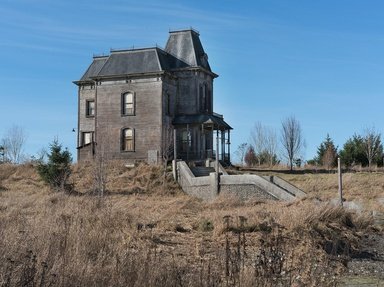Quiz Answer Key and Fun Facts
1. This British actress, playing the lonely wife of an older Scottish farmer, saves the film's hero by hastening his exit from her home. With the cops at the door, she gives her husband's overcoat to the hero and sends him out the back door to freedom. The coat will later save the man's life. Who is the actress and what is the 1935 Hitchcock spy thriller?
2. This Australian actress received a best supporting Oscar nomination for her legendary performance as a dangerous domestic in one of Hitch's early American films. Mourning the death of her employer's first wife, she torments her new mistress to the point of near madness. Who is the actress and what is the Hitchcock film?
3. Hitchcock used this American actress in two of his earliest American films. In the second of the two films, for which she won an Oscar, her character is recently married to a charming but unreliable gent, played by an atypically menacing Cary Grant. She loves him dearly but begins to think, with good reason, that he may be trying to kill her. Who is the actress and what is the Hitchcock film?
4. In her single Hitchcock film, this American actress played a young girl who begins to have troubling suspicions about a once beloved family member. When the suspected family member catches on, our heroine realizes that her life may be in danger. Known for her girl-next-door persona, this underappreciated actress is brilliant in this small-town thriller. Who is the actress and what is the Hitchcock film?
5. In her first film for Hitch, this icon of Hollywood's Golden Age played opposite Gregory Peck. The pair fall in love at first sight, but he is not who she first thinks he is, and she must employ her professional skills to get to the heart of the mystery. Oh, and there's skiing. Who is the actress and what is the Hitchcock film?
6. This charming and bubbly actress plays second fiddle to the leading lady, but she steals the show in this early fifties Hitchcock thriller. The younger of a U.S. Senator's two daughters, she is at a party when a murderer becomes fixated on her - her glasses, it seems, remind him of a woman he strangled earlier. Who is the actress and what is the Hitchcock film?
7. This popular American actress, best known for musicals and romantic comedies, made one film for Hitch. As the mother of a kidnapped boy in this mid-fifties Hitchcock thriller, the actress in question employs her considerable singing skills at a climactic moment. Whatever! Who is the actress and what is the Hitchcock film?
8. In one particular Hitchcock film, this American actress -- known for her upscale elegance and poise -- mans a shovel, climbs into a building through a second-story window, and tussles with a man once inside. She is then arrested for burglary. Who is the actress and what is the Hitchcock film?
9. Groomed by Hitch to be his new discovery, this actress played supporting roles in two of his films but dropped out of a third when she became pregnant. In her first Hitchcock film, she played a young wife and mother who suffers a mental breakdown after her husband is arrested. In her second Hitchcock film, she plays a sister. (Sister -- that's all you're getting.) Who is the actress and what is the first Hitchcock film she was in?
10. In her film debut, this actress plays a woman having a really bad weekend. She pursues a man romantically, but his mother is not happy about it. Another woman calls her "Evil. EVIL!!!" And then there's that terrifying business in the attic. Who is the actress and what is the Hitchcock film?
Source: Author
matriplex
This quiz was reviewed by FunTrivia editor
skunkee before going online.
Any errors found in FunTrivia content are routinely corrected through our feedback system.
